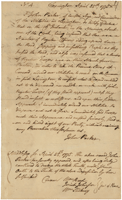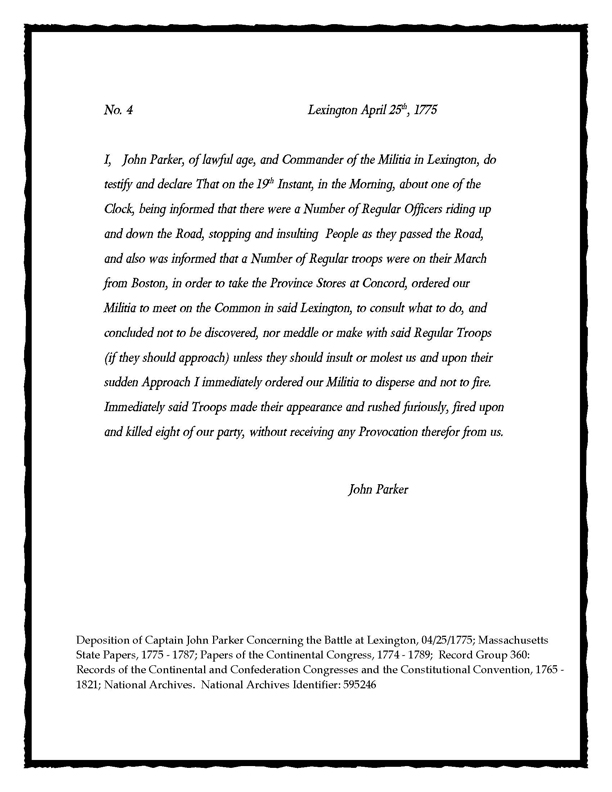
Teachable Texts: Who Fired the Shot Heard 'Round the World?
Prequel to Independence: Who Fired the Shot Heard 'Round the World?
Documents
Meeting in Watertown on April 22, 1775, following the April 18th incident in Lexington, the Second Provincial Congress of the Massachusetts Bay Colony:
Ordered, That Mr. Gerry, Col. Cushing, Col. Barrett, Capt. Stone, Doct. Taylor, Mr. Sullivan, Mr. Freeman, Mr. Watson, and Esquire Dix, be a committee to take depositions, in perpetuam, from which a full account of the transactions of the troops, under general Gage, in their route to and from Concord, &c., on Wednesday last, may be collected, to be sent to England, by the first ship from Salem.
(From Journals of the Second Provincial Congress, V2 Acts 1769-1780; Session laws; Boston : Secretary of the Commonwealth. )
Captain John Parker of Lexington, in charge of the militiamen who had gathered on Lexington Green on the evening of April 18th and the morning of April 19th, provided this deposition, one of a series of depositions taken shortly after the incident. Accounts of British soldiers and farmers in the countryside also exist.
Historical Background
By the rude bridge that arched the flood,
Their flag to April's breeze unfurled,
Here once the embattled farmers stood,
And fired the shot heard round the world.
from Concord Hymn, Ralph Waldo Emerson, 1837
Events Leading to the Incident
In the 1760s and 1770s, Committees of Safety consisting of every male of the community started to appear throughout colonial America as a way to discuss colonial concerns and to monitor British activity. These local committees usually controlled the local militias. These local committees sent representatives to county-level and colony-level assemblies to represent their local interests. As the royal officials were expelled, these local committees became the operating government of all the colonies.
In the Province of Massachusetts Bay in 1774, the regularly scheduled October meeting of the Massachusetts General Court was cancelled by the newly appointed governor General Thomas Gage because of local unrest. In response, the members of the Massachusetts House of Representatives met anyway in Concord and organized themselves as a Provincial Congress that included members of the former Plymouth Colony, Massachusetts Bay Colony, and Maine. With John Hancock as Provincial Congress president, this governing body became the unofficial government of Massachusetts (except the area around Boston that was still under British control) and the first autonomous governing body in the colonies.
The Incident
On the evening of April 18, 1775, the British authorities, acting on information that a supply of ammunition for the local militia was being stored in Concord, sent British regular troops from Boston to confiscate the arms. Skirmishes occurred in several places, most notably on Lexington town green and afterwards at Old North Bridge spanning the Concord River in Concord. The incidents are referred to as the Lexington Alarm and the Battle of Concord. The excursions of the British troops from Boston through the countryside to Lexington and Concord and back are the subject of this Teachable Text document.
The colonists felt wronged. They had been fired upon unjustly. As English subjects in America, they decided to relate what had happened to the King. The Provincial Congress appointed representatives to collect eyewitness reports about what occurred in Lexington and Concord between colonists and British troops. They sent these depositions to England and to the Second Continental Congress which was meeting in Philadelphia. Today, they are preserved as the Papers of the Continental Congress . (Record Group 360; National Archives).
Learning Activities
Examine it!
- Look up the vocabulary related to this document's event and create a list with the words and definitions: deposition, affidavit, Committee of Safety, Committee of Correspondence, Sons of Liberty, Parliament, broadside, militia, provisional, charter, Massachusetts Government Act, May 1774, coercive, intolerable, instant.
- Imagine you are John Parker. Sequentially paraphrase the document's information. Writing in the first person, relate how you learned of what was occurring from the time someone knocked on your door. Include the decisions you made as the militia captain.
Collect Needed Knowledge of the Time and Place
- Read the Provincial Congress's perspective of the evening of April 18th in A Narrative, of the Excursion and Ravages of the King's Troops Under the Command of General Gage , on the nineteenth of April, 1775: Together with Depositions. Massachusetts Bay: Worcester: Printed by Isaiah Thomas, by order of the Provincial Congress, 1775. Massachusetts Historical Society.
- Read the British perspective of the evening of April 18th in General Gage's Instructions, of 22d February 1775, An Account of the Transactions of the British troops , from the time they marched out of Boston, on the evening of the 18th 'till their confused retreat back, on the ever memorable Nineteenth of April 1775. Massachusetts Historical Society.
- Examine a map of Boston and surrounding areas. Find Charlestown, Old North Church, Boston Harbor, Lexington, and Concord.
- Read a picture book. Suggestions include: And Then What Happened, Paul Revere? by Jean Fritz or The Midnight Ride of Paul Revere by Christopher Bing.
- Create a timeline of Paul Revere's ride from Boston on April 18, 1775.
- Create a timeline of events leading up to April 19, 1775, beginning with the Treaty of Paris (1763). Use documents and illustrations to support your work.
Use it!
-
 Form groups of 3-5 students.
Examine additional colonial
depositions on DocsTeach.org, the National Archives' online tool for teaching with documents, and report what you have discovered from the stories therein.
Form groups of 3-5 students.
Examine additional colonial
depositions on DocsTeach.org, the National Archives' online tool for teaching with documents, and report what you have discovered from the stories therein.
- Create illustrations of the scene at Lexington Green or North Bridge based on this document and other eyewitness accounts of the incident.
- Sequence key events leading to the Declaration of Independence in the activity "Prequel to Independence" on DocsTeach.org, the National Archives' online tool for teaching with documents. The direct link
to the activity is: http://docsteach.org/activities/7168
- Write an explanation of the evening of April 18th from the point of view of a British soldier describing what occurred and why. Use these sources:
A Narrative, of the Excursion and Ravages of the King's Troops Under the Command of General Gage ,
on the nineteenth of April, 1775, General Gage's Instructions, of 22d February 1775,
An Account of the Transactions of the British troops , from the time they marched out of Boston,
on the evening of the 18th 'till their confused retreat back, on the ever memorable Nineteenth of April 1775.
- Consider the political climate of the day and what ignited the colonists and British commanders in Massachusetts to see the need for the public to know what happened to each of them on the evening of April 18, 1775. Role play a situation from the colonial or British troops' perspectives of why the printed accounts of what happened were necessary.
Extension Activities
- Analyze "Concord Hymn" by Ralph Waldo Emerson (1837) and "Paul Revere's Ride" by Henry W. Longfellow (1861).
- Arrange a choral reading of the poems for an audience.
- Compare and contrast the actual accounts of the events of April 18th with the version in Longfellow's poem.
- Compare and contrast the actual accounts of the events of April 19th with Emerson's poem.
- Get to know the names and faces of the times. Some of them are John Hancock, Paul Revere, Samuel Adams, John Adams, Abigail Adams, James Otis, Mercy Otis Warren, and Joseph Warren.
- Research and write biographies of some of the key people involved in the incidents in Massachusetts.
- Gather pictures of the events and people and create a slideshow.
- Role play and create a Biography Convention, wax museum, or tableau vivant of these important people.
- Research how the militias in the communities surrounding Boston were involved in the events of 18th and 19th of April, 1775. What was the atmosphere in Boston when the British imposed a siege to the port of Boston?
Additional Resources
- See more documents and depositions about the battles at Lexington and Concord on DocsTeach.org, the National Archives' Online Tool for Teaching with Documents.
- Consult The Coming of the American Revolution from the Massachusetts Historical Society.
- Visit the National Parks and their web resources: Minuteman National Historical Park, Boston National Historical Park, and Adams National Historical Park.
- For historical background, see the Massachusetts Archives .
National History Standards
Grades K-4
- K-4 Historical Thinking: Historical Comprehension
- Standard 2B - Reconstruct the literal meaning of a historical passage
- K-4 Content Standards - Topic 3: The History of the United States: Democratic Principles and Values and the People from Many Cultures Who Contributed to Its Cultural, Economic, and Political Heritage
- Standard 4D - The student understands events that celebrate and exemplify fundamental values and principles of American democracy
Grades 5-12
- Grades 5-12 Historical Thinking
- Standard 2B Historical Comprehension - Reconstruct the literal meaning of a historical passage.
- Standard 2F - Historical Comprehension - Appreciate historical perspectives.
- Standard 5A -Identify issues and problems in the past and analyze the interests, values, perspectives, and points of view of those involved in the situation. n demonstrate understanding of the sources and experiences of the new immigrants
PDF files require the free Adobe Reader.
More information on Adobe Acrobat PDF files is available on our Accessibility page.
 Page 1 of the Deposition of Captain John Parker Concerning the Battle at Lexington, 04/25/1775; Massachusetts State Papers, 1775 - 1787; Papers of the Continental Congress, 1774 - 1789; Record Group 360: Records of the Continental and Confederation Congresses and the Constitutional Convention, 1765 - 1821; National Archives. National Archives Identifier: 595246
Page 1 of the Deposition of Captain John Parker Concerning the Battle at Lexington, 04/25/1775; Massachusetts State Papers, 1775 - 1787; Papers of the Continental Congress, 1774 - 1789; Record Group 360: Records of the Continental and Confederation Congresses and the Constitutional Convention, 1765 - 1821; National Archives. National Archives Identifier: 595246  Page 2 of the Deposition of Captain John Parker Concerning the Battle at Lexington, 04/25/1775; Massachusetts State Papers, 1775 - 1787; Papers of the Continental Congress, 1774 - 1789; Record Group 360: Records of the Continental and Confederation Congresses and the Constitutional Convention, 1765 - 1821; National Archives. National Archives Identifier: 595246
Page 2 of the Deposition of Captain John Parker Concerning the Battle at Lexington, 04/25/1775; Massachusetts State Papers, 1775 - 1787; Papers of the Continental Congress, 1774 - 1789; Record Group 360: Records of the Continental and Confederation Congresses and the Constitutional Convention, 1765 - 1821; National Archives. National Archives Identifier: 595246 